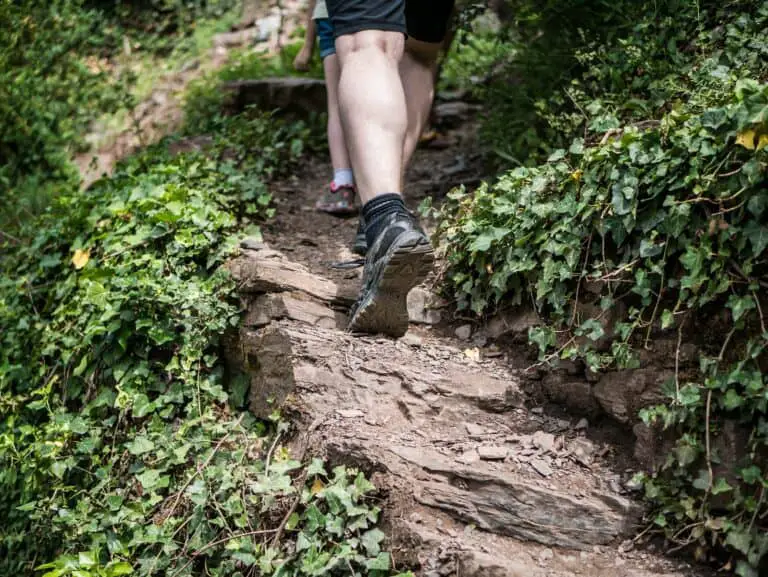Ever wondered if hiking can help tone your legs? I’ve got the inside scoop. In this article, we’ll delve into the benefits of hiking and how it can shape up your lower body.
Hiking isn’t just about breathtaking views and fresh air; it’s also a powerful leg workout. With every step, you’re engaging multiple muscle groups in your legs. Does hiking help tone legs? We’ll explore how this activity can lead to toned, strong legs over time.
Benefits of Hiking for Leg Toning

Hiking is more than just an adventurous activity – it’s a great way to get the legs toned. Not only is it a fun way to workout, but it can bring significant changes to your lower body. Here’s why hiking is beneficial for leg toning –
Hiking Engages Multiple Muscle Groups
When I take a hike, I’m not using just one set of muscles. Hiking engages multiple muscle groups in the legs including quads, hamstrings, calves, and glutes. And it’s not just about forward movement – when you’re stepping over a log or changing pace to climb a hill, a range of different muscles kick in. Trust me, it’s a much more comprehensive workout than you’d get with a basic gym routine.
Constant Change of Terrain
The actual terrain of a hiking trail keeps changing. Sometimes you’re walking on a smooth gravel path, other times you’re climbing over rocks or stepping on uneven ground. This constant changing terrain targets different muscles and aids in toning. So unlike walking on a flat treadmill, each hike can be a distinct workout. I find it always keeps my muscles challenged and guessing!
Extended Duration of Exercise
Hiking is a long-duration activity. On average, I am out hiking for two to three hours. This extended period of exercise enables a steady burn of calories, contributing to fat loss over the lower body. Plus it’s low impact, so I can keep up the pace without causing too much stress to my joints.
Improves Strength and Agility
You need a good core in order to stabilize yourself during a hike. Stabilizing your core makes you work on your lower body strength as you walk, climb, and maneuver through the trails. Over time, not only do my legs get a good tone, but they become more agile and flexible too. This combined improvement in strength and agility assists in shaping up the lower body. So next time you plan a workout, you might want to consider hiking for its comprehensive benefits.
Engaging Leg Muscles While Hiking

Hiking is more than just a simple stroll in the park. It’s a full leg workout that involves every major muscle group in your lower body. From your quads and hamstrings to your calves and glutes, every step you take on the trail provides an opportunity for muscle engagement, toning, and strengthening.
Quads get a serious workout while you’re hiking up inclines, and going downhill works on your hamstrings and calves. Glutes also get engaged when you’re pushing yourself uphill. So, it’s safe to say that hiking provides an all-round leg toning experience.
But don’t think it’s just these bigger, more prominent muscles doing all the work. The terrain variability in hiking – uphill, downhill, rocky paths, and uneven trails – also calls on your body’s small stabilizing muscles. These muscles are often overlooked during conventional workouts. Yet, their role is crucial in maintaining balance and agility over such unpredictable ground.
Stabilizing muscles participating in your hike are what really amp up the toning effect. These muscles are the real fatigue fighters, often working overtime to stabilize your body against the constant, unpredictable shifts in the trail terrain.
In essence, the fundamental muscle groups engaged during hiking include:
- Quadriceps
- Hamstrings
- Calves
- Gluteal muscles
- Stabilizer muscles
Also, it’s worthy to note that hiking is a long-duration activity. Hence, it leads to fat burning, which is crucial in revealing the already toned legs you’ve worked on during your hikes. The combination of these factors makes hiking excel as a total lower-body workout.
And let’s not forget about the increased strength, agility, and flexibility hiking gifts you. All these factors collectively contribute to the beautiful transformation of your lower body, making it stronger, leaner, and healthier. It’s the full package deal, my friends – just without the gym membership price tag attached.
Muscle Groups Targeted During Hiking
Hiking isn’t just an enjoyable leisure experienced in the great outdoors. It’s also brimming with health benefits, specifically helping to tone legs. Let’s dive deeper into the muscle groups you engage when you hit the trails.
The diversity of terrain when hiking is what sets this activity apart. Each stride you take, uphill or downhill, on rocky trails or smooth paths, involves different sets of muscles in your legs.
Walking uphill primarily works your quads and calves. Try it out—tighten these muscles for each step uphill and feel them work. For downhill strolls, you’re giving your hamstrings and glutes a good stretch and workout. These are the muscles that help you maintain control and avoid going down too fast.
But, there’s more to this than just challenging the main muscles in your legs. Hiking also targets your lower body’s stabilizing muscles. These muscles, often neglected in regular gym workouts, play a crucial role in maintaining balance and agility on uneven trails. Walking on unpredictable terrain requires constant micro-adjustments — that’s your small stabilizing muscles working tirelessly to keep you balanced.
Hiking chips away at stubborn fat while working core leg muscles, revealing a leaner, stronger lower body. By alternating between short bursts of intense hiking, followed by recovery periods, you’ll increase calorie burn rate. The toning effect is even more profound if the trail has various inclines and obstacles.
Though it often remains unsaid, hiking also subtly improves the strength and flexibility of your leg muscles. Surprisingly enough, with regular hikes, you’ll notice improved agility and endurance as well—making your everyday tasks seem just a bit easier.
An extra bonus? You can modify the intensity of the workout easily. Speed up or carry a weighted backpack, and you’ll feel your muscles respond sob. Slow it down when you need to, listen to your body. The joy of hiking is that it’s as challenging as you want it to be. What’s more, each hike is a chance to step towards stronger, more toned legs. The terrain is your multisystem gym, and nature provides the best views.
Laying down the notion, hiking does more than just elevate your mood and let you adore mother nature. It’s an all-round workout that consistently tests, strengthens, and tones the essential muscle groups in your legs. Engaging routes, brilliant views, and fitter legs—sounds
How Hiking Shapes Up Your Lower Body

Let’s dive right in, shall we? When you’re out on a hike, you’re utilizing a myriad of muscles in your lower body. Your quads, hamstrings, calves, and glutes are all called into action with each step you take. But it’s not just about the big muscles. Your body’s stabilizing muscles, often overlooked in traditional fitness regimes, are crucial in keeping you balanced and agile on the constantly shifting terrain beneath your boots. It’s this comprehensive engagement that allows for such thorough toning.
What’s more, hiking isn’t only about muscle building. It’s a potent fat-burning activity too. Sure, it’s not as high-intensity as a sprinting session at your local track, but remember, it’s a marathon, not a sprint. Hiking sees your body in constant motion over a prolonged period. This extended action translates into an efficient and sustainable burn of stored fats. As these fat deposits shrink, your toned muscles can finally shine through.
Another point to emphasize here is the way hiking naturally adapts to your fitness levels. I’m not suggesting rugged mountain trails straight off the bat, but as you progress, you can intentionally select harder trails with steeper inclines, looser footing, or both. Remember: no pain, no gain. This progressive intensification helps boost strength and agility, further toning your legs.
From hiking, you can also benefit from improved flexibility. As trails demand you step, lunge, and sometimes even scramble, you’re doing an unofficial full-body workout – with flexibility drills thrown into the mix. Over time, this will result in a leaner, fitter lower body, and to an extent, a more flexible physique.
To top it off, set amidst nature, hiking provides a stimulating and peaceful respite from the hustle and bustle that characterizes typical gym settings. It seems hiking not only helps tone your legs but also takes care of your wellbeing.
Tips for Maximizing Leg Toning Benefits During Hikes
Hiking is an excellent way to strengthen and tone legs. But to get the most out of this outdoor activity, you’ll need some specific strategies. Here are some tips that can help you carve your legs and shape up your lower body:
Take on Steep Trails
Hiking up and down steep trails brings your leg workout to the next level. This kind of terrain forces your muscles to work harder. It’s like adding weights to your normal workout routine! However, always remember that safety comes first. Only take on these trails if you feel confident and are in good physical condition.
Alternate Your Pace
Varied intensity in hiking can provide major benefits. For instance, hiking quickly for an interval followed by slower recovery periods helps to build endurance and strength. This method, commonly known as high-intensity interval training (HIIT), not only boosts leg toning but also increases overall fitness.
Incorporate Lunges and Squats
Bodyweight exercises like lunges and squats effectively tone leg muscles. During your hike, take a few moments to incorporate these exercises. For example, do some lunges during a break or add a few squats when you reach a beautiful vista.
Use Trekking Poles
Trekking poles are not only handy for navigating difficult paths—they also help in toning your legs. Using these poles during your hike engages your upper body as well, turning your hike into a full-body workout.
Going Beyond Aesthetics
Engaging in hiking extends benefits beyond just toned legs. This activity also benefits your heart health, lung capacity, and overall physical condition. And let’s not forget the mental health benefits—hiking allows you to enjoy the tranquility of nature, reduce stress, and boost mood.
So, lace up those boots and hit the trails! You’ll simultaneously enjoy beautiful views, reap substantial health benefits, and enhance your leg muscles. And, by incorporating these tips, you’re sure to maximize the toning benefits of your hiking excursions.
Conclusion: Does Hiking Help Tone Legs
So there you have it. Hiking is a fantastic way to tone your legs, and with a few simple strategies, you can maximize your results. Remember, it’s not just about the destination, but the journey. Incorporating lunges, squats, and using trekking poles into your hikes can add an extra toning boost. But don’t forget, hiking’s benefits extend beyond the physical. It’s also a great way to improve your heart health, lung capacity, and mental well-being. So why wait? Lace up those boots and hit the trails. Your toned legs and improved overall health are waiting for you. Happy hiking!

